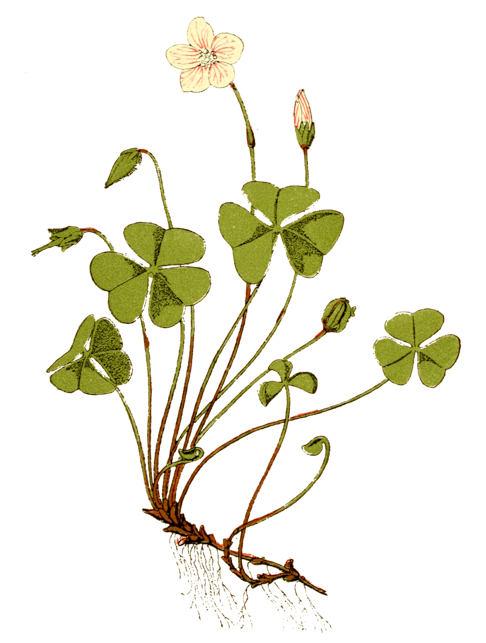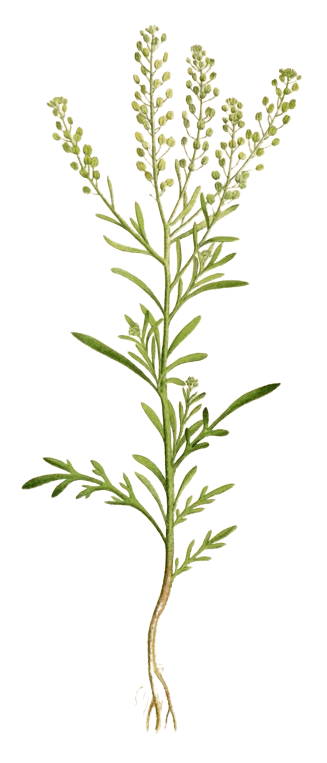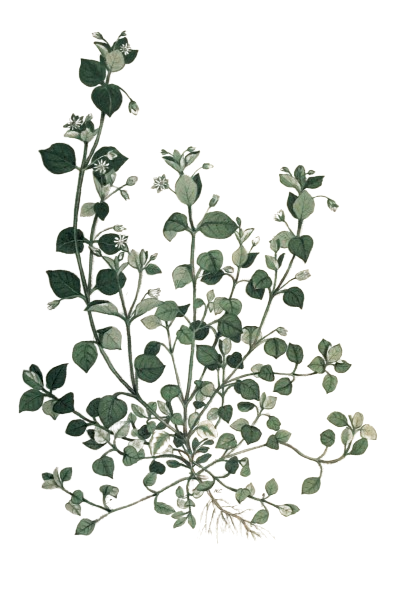






There is no such thing as a weed!
"Weed" is not a fixed category or type of plant, and it is not a descriptive term. It is a word used for anything growing in a human-managed space which was not intentionally planted there, which means that anything can be a weed! Whether or not a plant is a weed is completely dependent on context and the individual person interacting with the plant.
An easy example: grass on the lawn is not a weed, but grass in the flowerbed is a weed.
Since a weed is just a plant you see growing where you don't want it to, it is typically used to describe plants which grow quickly and establish themselves easily, because those are the things you're going to be pulling up a lot of when you weed your garden.
Instead of calling something a "weed", it's good to use a more specific term; I'll be explaining a bunch of those here!
I live in North America / Turtle Island, so my specific examples are going to be centered around the plants that grow here and around me!
In many gardening circles, the emphasis placed on planting native species might lead one to assume that non-native species are all No Good, harmful, weeds, or invasive. That is not the case!
A plant being native or non-native is a neutral thing. It just indicates where it is originally from, and thus what organisms it is adapted to live alongside and what environment it is accustomed to.
A plant being non-native to your area often means that it has more particular care needs and needs more care and attention than a native plant. It isn't used to the weather, sunlight, soil type, diseases, and insects in your area! Maybe it's from somewhere where the ground stays frozen until late April, but where you live the ground is good for planting in February; that's something you need to account for when you're planting something, because it affects its growth cycle.
Since a non-native plant isn't originally from around you, it may not be as beneficial to the local ecosystem as a native plant might be – there are lots of insects adapted to specific plants whose needs won't be met by a plant that it didn't evolve alongside, for example. There are lots of bugs that only eat specific plants – monarch butterflies in their caterpillar form famously only eat milkweed!
That doesn't make it harmful or useless, though! It is just a factor that is worth noting and keeping in mind.
There's not a super hard line between what counts as native vs non-native. Not everything present in your local ecosystem is going to be something "native" to your area, because when people move around we carry animals and seeds and fungi and germs with us! Both intentionally and unintentionally.
We've also been intentionally cultivating plants for a very long time, and lots of plants have been bred to be adaptable or tolerant of a variety of growing conditions.
It's still useful as a general shorthand to mean "plants that are or are not particularly adapted to and incorporated into an area," though, because it helps to remind you to think of how something will fit into the general ecosystem it's being inserted into! What role will it fill, and what might it need in order to succeed?
"Invasive species" is a category whose members are defined by a government, typically an enivronmental or agriculural department! Invasive plants are non-native plants which grow quickly and aggressively and whose growth is harmful to native biodiversity.
These are plants whose presence needs to be actively managed by humans, because they're too good at adapting to their non-native environments and take over their new homes by damaging the native plants. They can do this in a number of different ways!
Garlic mustard - alliaria petiolata - its roots exude chemicals which disrupt the underground mycorrhizal fungi networks that keep soil healthy and enable other plants to grow and communicate with each other. This makes life much more difficult for everything around it!
The entire plant is toxic, in fact! It can't be digested by most of the herbivores here in North America, big ones like deer and small ones like insects. In its native range there are loads of things that eat it, but not here. This means that deer and other wildlife will eat everything but the garlic mustard, giving it a significant advantage, on top of the garlic mustard making it difficult for the plants being eaten to grow back.
Oriental bittersweet - celastrus orbiculatus - climbs anything it can grab onto and kills trees by strangling them – wrapping tightly around their trunks, preventing circulation of nutrients – as well as by snapping them with the weight of its accumulated growth. It grows very quickly and is incredibly difficult to get rid of once it's established, because its roots grow as long and thick and far as the rest of it! And when the plant's aerial roots are damaged, its enormous underground root systems get bigger to compensate!
Bittersweet vines form enomous blanketlike masses of twining vines, which – on top of the weight and the strangling – block the sun and create densely shaded areas that impede the wellness of the undergrowth.
Invasive plants require human intervention in order to be managed; when left to their own devices, they are incredibly disruptive and threatening to biodiversity and the survival of native species! Besides humans, the ecosystem does not have anything in place for managing or balancing the growth of these plants. Often, these plants adapted to grow so aggressively because it was necessary in their home environments; they're used to having things impeding their growth which are not present in their new environments. It's important to remember that we inhabit environments that are dependent on us as much as we are dependent on them. Humans aren't separate from nature, nor should we try to be.
While weed is a very broad and nebulous term, "noxious weed" is not! Like invasive species, noxious weed is a category delineated by a government for the purposes of agricultural regulation. It's a plant which is harmful to farms, something which interferes with crops, and/or is poisonous to humans or the animals we care for!
This is a pretty specific category of plant – and, note that it is not the same as invasive! A noxious weed is not necessarily non-native nor invasive. Many noxious weeds are, but not all of them! Honey mesquite, for example, is native to Mexico and the southwestern States, but is still considered a noxious weed.
A great example of a noxious weed is yellow starthistle (Centaurea solstitialis), which is also an invasive species. If a horse eats a lot of yellow starthistle, it will die of a degenerative condition called "chewing disease" – there is no cure for it, and it specifically affects horses! Yellow starthistle flowers also have huge spikes that hurt the mouths of a lot of grazing animals like cows.
Not every poisonous or harmful plant is considered a noxious weed, though. As with invasive species, different areas have different lists of what they consider a noxious weed!
Many things considered weeds are called such because they grow quickly and thrive in suboptimal conditions. Plants which grow through the cracks in parking lots or spring up in piles of dirt left sitting for a few weeks, for example.
Despite their poor reputation for being harmful or useless, weeds have a place and a function in an ecosystem just like everything else. As you may have heard in very different contexts: the purpose of a system is what it does. What they do is their purpose: to grow where nothing else grows.
Many things considered weeds - both invasives and non-invasives - are what you can call disturbance-adapted colonizer plants.
Let's take a patch of dirt by the side of the road in a city. Whatever this environment used to be hundreds of years ago is totally different; the light, the temperature, the soil makeup, the animals, et cetera.
This dirt patch is a hostile environment for a lot of plants. It gets walked on and kicked and driven over. It gets very little shade, few visits from animals, and it's scattered with litter and runoff. There are no trees nearby, there's no moss or lichen. All kinds of nasty stuff from has seeped into that soil: gasoline, pesticides, garbage, vape juice, drain cleaner. (Humans love poison!) It lacks nutrients and is instead full of all kinds of weird junk. Every time it rains it gets a fresh helping of runoff from the road.
And yet, things can and do grow in it anyway! Disturbance-adapted colonizer plants are able to take root in even the most hostile environments, and simply by existing they improve their own conditions.
A plant with a deep taproot pulls nutrients up from deeper in the soil and take them up into its body; when it drops leaves or dies, those nutrients are able to be incorporated into the soil closer to the surface.
Plants can also extract pollutants from the soil, taking them in and removing them from the environment just like they do from the air.
Colonizer or pioneer plants are the first wave of a piece of land rebuilding itself; they are a necessary step in restoring health and biodiversity to a space. Other plants cannot grow there yet, but the plants who can are improving the environment and making it habitable for the less hardy plants that will come after it.
When these colonizer plants are pulled up and disposed of elsewhere, their work - the healing process! - is interrupted and the land they're growing on remains an environment inhospitable to other (more desirable for humans) life. Think of it like picking at a scab; it might be itchy and ugly, but it's supposed to be there and you need to leave it alone until it's done with its work!
Here are some examples of weeds working hard in my area and some of the benefits they provide!
Lambsquarters - chenopodium allum - extracts heavy metals from the soil it lives and can act as a sort of bodyguard to some crops by attracting leaf-eating bugs to it instead of the crops! How noble!
White clover - trifolium repens - clover is particularly excellent at nitrogen fixation and is adored by pollinators and herbivores of many kinds! Honeybees love clover flowers. Clover is also a nutritious crop for grazing animals, and a convenient alternative to grass lawns because it doesn't grow very tall and usually doesn't need as much water.
Dandelions - taraxacum officinale - the humble and much-aligned dandelion is the classic taproot weed! With its taproot it helps bring up otherwise inaccessible nutrients and aerate the soil, and every part of the dandelion is edible to humans! The leaves, flower, and roots can be (and are!) eaten by people throughout history. Be careful if you're tempted to try munching on some, though; dandelions are frequent targets of herbicide and are likely to be contaminated if you harvest them from a lawn or other maintained grassy area. Don't eat poison!!